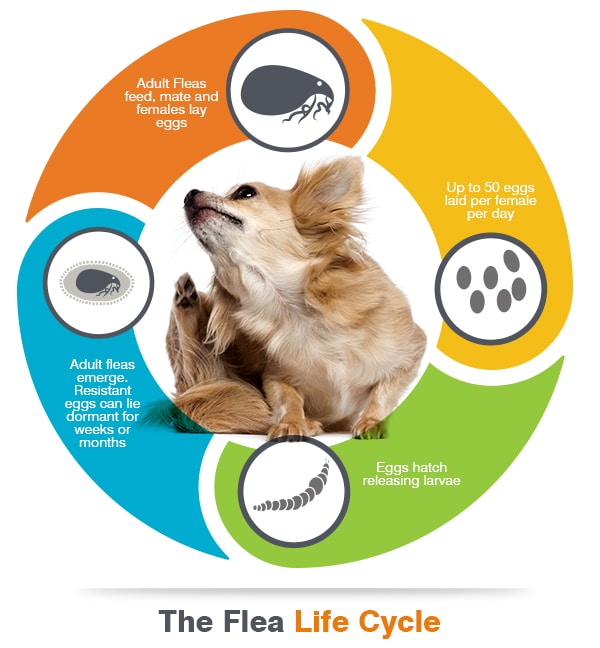
There is nothing worse than spotting a flea on your pet and while treating fleas on dogs and cats might sound easy, getting rid of them permanently is a whole other matter.
Although dogs and cats usually get fleas from picking up newly hatched fleas from a contaminated environment, it is possible for adult fleas to jump from one animal to another, setting up an infestation. So, if you think your cat is safe because it is an indoor cat only and you also own a dog, think again.
Fleas are not always species-specific, meaning fleas from dogs can infest cats, and vice versa. In fact, did you know that the most common flea affecting dogs is actually called the cat flea?
Not only can fleas cause itching, scratching, and skin irritation in pets, leading to discomfort and even secondary skin infections, they can do the same to us so treating fleas on dogs and cats as soon as you notice them is imperative.
A tell-tale sign that your pet has fleas, if you don’t notice the creepy critters crawling over your dog or cat’s belly, is the black stuff that looks like pepper, often found if you pull apart the hair, particularly around the base of your dog and cat’s tail.
If fleas are left untreated they can lead to flea allergy dermatitis, which is extremely uncomfortable and can be dangerous for your pet. Many dogs suffer greatly from this condition and often require frequent vet visits to help relieve their discomfort and pain associated with it.
Fleas can also carry and transmit diseases to pets, such as tapeworm, and they play a role in spreading the bacteria responsible for cat scratch disease, meaning they pose a human health risk as well.
The adult fleas you see are just tip of the iceberg, only 5% of the problem – with the remainder of the population existing as juvenile stages in the environment.
Fleas can lay around 50 eggs per day, with an adult female flea producing more than 2000 eggs in her lifetime. The eggs are often laid on the coat of the pet but then fall into the environment where they develop.
Tiny, worm-like larvae then hatch from the eggs and burrow into carpets, under furniture, your pet’s bed or into soil before lying dormant as pupae before the adult flea emerges to jump on to a host.
As you can imagine breaking this cycle is time consuming, costly and challenging, mainly due to the sneaky pupal stage which can lie dormant in a house for up to one year, suddenly emerging and causing an infestation.
So, while treating fleas on dogs and cats is important, removing them from your home environment, and anywhere else they frequent is vital.
When it comes to preventing and treating fleas on dogs and cats, prevention really is better than cure. You can use a highly effective flea control product like NexGard SPECTRA to protect your dog, but if they already have an infestation, it can also be used for treating dogs with fleas.
Nexgard will soon be releasing a version for cats, so it is important that you choose a product that is species-specific – never use a dog product on a cat and vice versa.
You will also have to vacuum all areas, and wash everything wash bedding, blankets, pillows, couch covers at the highest heat setting and potentially also treat your house with insecticides – which is not great for us or our pets’ health.
This helps to break the cycle, but until all the eggs in the environment have been removed or hatched, the fleas will just keep coming back – so getting a flea problem under control which can take many months!
So, for peace of mind and to avoid the hard work and health issues associated with a flea infestation in your home, ensure you keep your dog and your cat’s parasite protection up to date.
Other steps in your treatment regime should include:
Routine checking – Look for fleas or that tell-tale ‘flea poo’ any time you brush or shampoo your dog or cat, or when you return home from areas that are likely to have higher numbers of fleas or if they have been around other pets.
Keep it clean – Reduce the flea population in your house by thoroughly cleaning your pet’s sleeping quarters and vacuuming floors and furniture that your pet comes in contact with frequently. Careful and regular vacuuming/cleaning of the pet’s living area helps to remove and kill flea eggs, larvae and pupae.
Flea/lice combs – Your pet will love the extra hands-on attention he gets as you comb through his coat to remove fleas. When it comes to treating fleas on dogs and cats, flea/lice combs are a safe method to use on ill, pregnant or young pets. Place the fleas you comb off in detergent water to kill them.
Need advice? See your veterinarian if your pet excessively scratches, chews, or licks its coat, or persistently shakes its head. These clinical signs may indicate the presence of external parasites or other conditions requiring medical care.
 Want to know more about fleas?
Want to know more about fleas?Fleas are 2-8 mm long (no bigger than a sesame seed) with fantastic jumping ability. Adult fleas are dark brown and able to move rapidly over your pet’s skin.
Fleas have eyes and antennae, which detect heat, vibration, carbon dioxide, shadows and changes in air currents, all of which indicate a possible meal is nearby. Fleas feed on the blood of animals. They can go several months without a meal. Fleas may also bite humans. Fleas thrive when the weather is warm and humid. Depending on your climate, fleas may be a seasonal or year-round problem. Your pet can pick up fleas wherever an infestation exists, often in areas frequented by other cats and dogs
There are four stages in the development of fleas (this cycle varies from 12 days to 6 months):
About the Author: Dr Melissa Meehan is a highly experienced and respected veterinary surgeon with over 14 years experience. Dr Melissa obtained her Members in Small Animal Medicine through examination in 2008 and now runs her own veterinary ophthalmology service.



Bladder Stones in Dogs and Cats

Support dog gut health when taking medications



Get your paws on Lara Shannon’s best selling books ‘Eat, Play, Love (your dog) and World of Dogs.
Available in Australia, USA, UK and Canada.